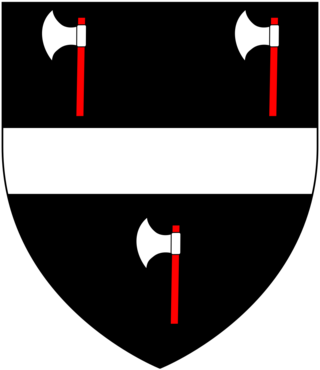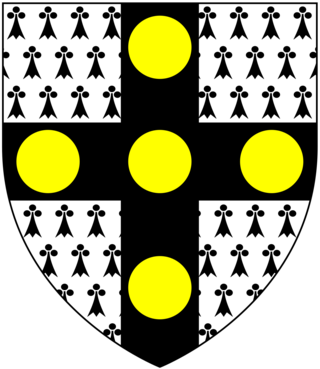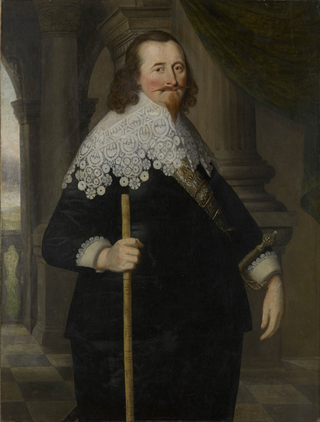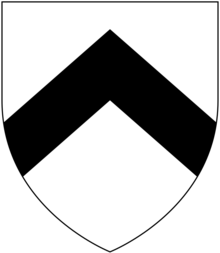
Viscount Combermere, of Bhurtpore in the East Indies and of Combermere in the County Palatine of Chester, is a title in the Peerage of the United Kingdom. It was created in 1827 for the prominent military commander Stapleton Stapleton-Cotton, 1st Baron Combermere. He had already been created Baron Combermere, of Combermere in the County Palatine of Chester, in 1814, also in the Peerage of the United Kingdom. He had previously inherited the baronetcy, of Combermere in the County Palatine of Chester, which was created in the Baronetage of England on 29 March 1677 for his great-great-grandfather Robert Cotton.

Sir Jonathan Trelawny, 2nd Baronet, of Trelawny in the parish of Pelynt in Cornwall, England, was a Cornish Member of Parliament.

Sir John Trelawny, 4th Baronet, of Trelawne in Cornwall, was a Cornish politician who sat in the House of Commons from 1713 to 1734. Trelawny was the eldest son of Sir Jonathan Trelawny, 3rd Baronet and his wife Rebecca Hele, daughter of Thomas Hele of Bascombe, Devon. His father was Bishop of Bristol, Bishop of Exeter and Bishop of Winchester. He matriculated at Christ Church, Oxford on 26 January 1708. He married Agnes Blackwood daughter of Thomas Blackwood of Scotland. He succeeded his father in the baronetcy on 19 July 1721.

There have been two baronetcies created for the Guise family, one in the Baronetage of England and one in the Baronetage of Great Britain. The latter creation is extant as of 2014.

The Wrey Baronetcy, of Trebitch in the County of Cornwall, is a title in the Baronetage of England. It was created on 30 June 1628 for William Wrey (d.1636), 2nd son of John Wrey of Trebeigh, St Ive, Cornwall, a member of an ancient Devon family. The third Baronet was a supporter of the Royalist cause and sat as Member of Parliament for Lostwithiel after the Restoration. He married Lady Anne, third daughter and co-heir of Edward Bourchier, 4th Earl of Bath, and a co-heir to the barony of Fitzwarine. The fourth Baronet represented Liskeard and Devon in the House of Commons. The fifth Baronet was Member of Parliament for Camelford while the sixth Baronet represented Barnstaple.

Brigadier-General Henry Trelawny was a British Army officer of Cornish descent, a Member of Parliament and Vice-Admiral of Cornwall.
There have been three baronetcies created for persons with the surname Pole, one in the Baronetage of England, one in the Baronetage of Great Britain and one in the Baronetage of the United Kingdom. Two of the creations are extant as of 2008.

Sir Harry Trelawny, 5th Baronet, of Whitleigh, Devon, was a British Army officer and Tory politician who sat in the House of Commons from 1708 to 1710.

The Fagge Baronetcy, of Wiston in the County of Sussex, is a title in the Baronetage of England.

There have been two baronetcies created for persons with the surname Goring, both in the Baronetage of England. The second creation came into the family through a special remainder in the patent creating the baronetcy. Only the latter creation is extant as of 2008.

The Molesworth, later Molesworth-St Aubyn Baronetcy, of Pencarrow near St Mabyn in Cornwall, is a title in the Baronetage of England. It was created on 19 July 1689 for Hender Molesworth, Governor of Jamaica. The second Baronet sat as Member of Parliament for Lostwithiel and Bossiney. The fourth Baronet represented Newport and Cornwall in the House of Commons. The fifth and sixth Baronets sat as Members of Parliament for Cornwall. The eighth Baronet was a prominent Radical politician and served as Secretary of State for the Colonies from July to October in 1855.

There have been three baronetcies created for persons with the surname Carew, two in the Baronetage of England prior to 1707, one in the Baronetage of Great Britain.

Sir John Trelawny, 1st Baronet was a Cornish baronet and soldier from Trelawne, Cornwall. He was High Sheriff of Cornwall. A Royalist MP, he fought for Charles I in the English Civil War.

Sir William Trelawny, 6th Baronet, of Trelawne, Cornwall was a British politician and colonial administrator.

Sir William Lewis Salusbury-Trelawny, 8th Baronet, was a British politician.

Sir John Salusbury Salusbury-Trelawny, 9th Baronet, was a British Liberal politician.
There have been six baronetcies created for persons with the surname Price, one each in the baronetages of England and of Great Britain and four in the baronetage of the United Kingdom. Two of the creations were extant as of 2008.
John Trelawny may refer to:
Trelawne is an historic manor in the parish of Pelynt in Cornwall, England, situated 20 miles (32 km) west of Plymouth, Devon and four miles (6.4 km) west-northwest of Looe, Cornwall. It was long the seat of the Trelawny family, later Trelawny baronets, one of the most eminent of Cornish gentry families, much of whose political power derived from their control of the pocket borough of nearby East Looe. The surviving grade II* listed manor house known as Trelawne House is today used for holiday accommodation and entertainment, under the name "Trelawne Manor Holiday Park".
Trelawny or Trelawney is a habitational surname that originated in Cornwall. The family are said to have descended from Haemlin, who held several manors from Robert, Count of Mortain, according to the Domesday Book.









